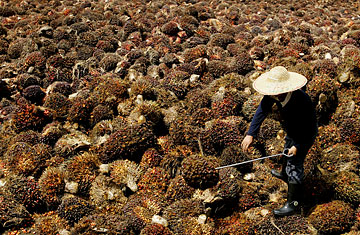
A worker arranges palm-oil fruits at a factory on the outskirts of Kuala Lumpur on April 4, 2006
Anyone wondering how Southeast Asia will cope as it embraces a sweeping new free-trade agreement with China, creating one of the world's biggest free-trade zones, may learn from the behavior of the shimmering dragonfish that Kenny Yap breeds on his jungle-fringed farm in northern Singapore.
With their dazzling orange and gold skins and fat bellies, the individual dragonfish are soothing enough to watch swim around Yap's tanks. Until, that is, they are paired with another dragonfish, after which they present a more gruesome spectacle. "They either try to eat each other or fight each other to the death," explains one of Yap's employees, who pairs each dragonfish with a stingray, which hovers over the tank's bottom and stays out of his aggressive neighbor's way.
Co-habitation is possible, in other words, but direct competition can be deadly. That's a lesson Southeast Asia's companies are braced to learn as Chinese manufacturers loom ever larger on their doorstep, unfettered by the duties and tariffs that before Jan. 1, when the free-trade agreement kicked in, gave local businessmen a small measure of protection.
The rumbling of Chinese competition has been growing steadily louder this month. According to the Bangkok Post, for example, China's consumer appliance giant Haier is planning to take advantage of the FTA by investing $9 million more into its factories in Thailand to churn out more fridges, washing machines and air conditioners. Indonesia is so jittery by the prospect of such moves that the country's Trade Minister, Mari Pangestu, has notified the secretariat of ASEAN (Association of Southeast Asian Nations) that Jakarta wants to delay the inclusion of hundreds of domestically produced items like textiles, food products and electronics from the accord, fearing that local Indonesian industries could be swamped by cheap Chinese goods.
"An increase in cheaper foreign-sourced goods can lead to inferior quality and buying decisions being made in favor of price over quality," says Peter Wong, an executive director with HSBC in Hong Kong. Vietnam, too, could lose in this scenario, as many of its manufactured products compete directly against Chinese goods on the global marketplace on the basis of lower cost.
Still, the opportunity that the agreement opens up for Southeast Asia is huge. According to HSBC, the China-ASEAN free-trade area will encompass 1.9 billion people and a combined GDP of $6 trillion. To capitalize on this vast market, economists advise Southeast Asian companies to specialize in niche goods and services that China cannot duplicate — and to do it fast. "Given the shifting nature of China's comparative advantage, Asian countries may best re-orientate their economies towards sectors that cannot be easily replicated by China," wrote Kit Wei Zheng, a Singapore-based economist with Citigroup, in a 2009 report entitled "Who Benefits Most From China's Domestic Demand?"
Crude palm oil from Malaysia, which produces 45% of the global supply, is one commodity for which China has a vast appetite, yet cannot produce, according to research analyst Mark Matthews of Macquarie Securities. Low-grade electronics manufacturers in Thailand and Malaysia also stand to be beneficiaries. "These two markets are well positioned to take China's place at the lower end of the production network," says HSBC's Wong.
It's businesses like Yap's ornamental-fish-breeding company — a nimble, small-to-medium-size specialized enterprise that trades with China but does not directly compete with Chinese companies — that stand to benefit the most from unfettered access to China's one billion customers. Sixty percent of the world's supply of ornamental fish comes from Southeast Asia, whose warmer waters and diverse aquatic eco-system has given it a competitive advantage that China cannot easily wrest away. A fully grown dragonfish, which Yap says aspiring Chinese businessmen gravitate to, can fetch up to $20,000 — each. Producing the fish isn't easy; eggs are often held inside a male dragonfish's mouth until they hatch. When they're sold, Yap implants a microchip in its belly and delicately packs it in pre-oxygenated cold water, often to be sent north to China by plane.
Before the free-trade agreement kicked in this month, Yap was paying customs duty in China on his fish that amounted to roughly 6% of their cost, he says. As a result, China only made up slightly less than 10% of Qian Hu's $67 million in 2009 revenue, a share that Yap aims to triple over the next five to 10 years now that the tariff is gone.
"Fish and water are very auspicious words in Chinese," says Yap, smiling. "Water means wealth and fish means surplus. Keeping fish is a very good omen for those Chinese who want to get wealthy." Yap is bound to keep growing wealthy from his fish too, as long as he swims alone and steers clear of fearsome Chinese predators.
